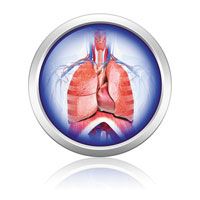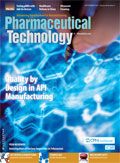Fit for the Lung?
Advances in engineered particles and the subsequent reduction in the API mass required to achieve a therapeutic dose can lead to a reduction in side effects.
*This article originally appeared in Pharmaceutical Technology Europe*
PIXOLOGICSTUDIO/Getty Images

The surface area of an adult human lung is 70 to 100 m (1). The lung has been successfully used as a means of delivering APIs locally and systemically for many years. The key to successful delivery of an API to the lung is the generation of a particle that is sufficiently small to be delivered to the lung. The actual size of particle that can be deposited in the lung varies significantly from as small as 1 nm to particles of 10 µm but most pharmaceutical products try to achieve particles of the size range of 1.1 µm to 5 µm to enable delivery to the bronchial region of the lung (2).
The issue with micronisation
In a traditional asthma dry powder inhaler, the micronised API with a mass median diameter of between 1.1 µm to 5 µm would be blended with a milled carrier material, such as lactose, and filled into a capsule or device. A carrier is used because the API mass required to treat asthma is small. To achieve an acceptable dose content uniformity, the filling process needs to be accurate and the current weight limit for accurate dispensing is 1 mg (3). Upon inhalation, the API particle detaches from the lactose carrier and travels through the respiratory system until it impacts on the surface of the lung. This process of micronised API being blended with milled lactose has been used for decades.
The process, however, is far from efficient. The micronised API will have a varied particle size distribution. Many particles will be well below the 1.1-µm cut-off or above the 5-µm cut-off. The amount of API that falls between the two physiologically important sizes is perhaps as little as 30%. The remainder of the API will not be delivered to the desired region of the lung and will instead be deposited in the mouth or throat and swallowed. The majority of modern chronic obstructive pulmonary disease (COPD) and asthma medications have poor oral bioavailability and, therefore, the potential for adverse reactions from systemic delivery of these APIs is low, but future medications may not have that luxury. There is also an obvious cost issue if less than one third of the API is being delivered to the desired region, with two thirds of the API being “wasted”. Again, with COPD and asthma medications, the cost of the API is not astronomical but as the industry investigates treating other ailments via lung dosing, this issue will become a significant concern.
A second issue with micronisation and milling is the disruption that is caused to the surface chemistry of the API and the carrier. It is important to understand the surface chemistry of the API and any carrier material to ensure that a blend formulation produced consistently allows the API and lactose to disaggregate.
One of the key factors in understanding the potential performance of a blend is the API/carrier cohesion/adhesion balance. This is, in summary, how likely the API is to agglomerate together rather than adhere to the carrier and how strong any adhesion is. These parameters can be measured, which will allow a formulator to “fine tune” the formulation as required. It is important that this assessment is made on several different batches of carrier and API as the micronisation process can lead to significant differences between successive batches of product. Failure to perform these checks can lead to poor in-vitro and in-vivo performance of the blend.
A case for particle engineering
With these factors in mind, it is no surprise that alternate methods of producing inhaled particles have been investigated. Current research is focused on two areas that overlap. The initial work has been to simply replace the micronisation of the API with an alternate size reduction technology, such as spray drying or using supercritical fluids. These technologies are capable of controlling the final particle size, creating a tighter particle size distribution. As discussed earlier, this will help ensure that a greater API mass is deposited into the deep lung region and so that less material is lost. It also helps to reduce the cost of the product and the likelihood of systemic side effects.
There remains an issue with this process, given that the API will still require using a carrier to allow the filling of the device or capsule to be accurate and precise. Whilst the surface chemistry of the API may be better controlled, as the material is typically dissolved prior to manufacturing the microparticle, the formulation still relies upon milled lactose. It, therefore, remains important to assess the cohesion/adhesion balance of the blend on a regular basis to avoid unwelcome discoveries in the clinic.
The next logical step in the continued research into inhaled products is to create an engineered particle. The ideal engineered particle will have a closely controlled mass median diameter, contain both the API and an inert carrier in a matrix and could be accurately filled into a device or capsule without using a carrier.
One such method of creating an engineered particle is spray drying. In this process, the API and carrier are dissolved in a suitable solvent and sprayed through a fine nozzle at a defined flow rate to produce a droplet. As the droplet falls in the spray dryer, the solvent is evaporated leaving a single particle containing the API and inert material with a closely controlled particle size. This fine particle material can then be filled into a device or capsule for delivery by the inhaled route.
By combining a high mass of carrier with a low mass of API, a single particle of physiologically important dimension can be delivered to the deep lung. As both the API and carrier are solubilised prior to manufacture, the surface chemistry can be controlled more easily than typically seen in blend formulations.
Another benefit of the engineered particle approach is that the formulation development activities are significantly reduced. The creation of the “perfect blend” in inhaled product development can lead to the manufacture of dozens of alternate approaches. Using a single particle removes this requirement and, therefore, allows the developer to reduce their costs.
A potential downside of this process is that the material produced is amorphous. The change from crystalline material, as typically found in micronised powders and the amorphous material produced in spray drying, would need to be clinically assessed on a case-by-case basis.
The development of engineered microparticles will allow medicine developers to design therapies from the ground up. This includes defining the particle size to match the desired therapeutic destination and combining multiple APIs into a single particle to maximise the benefit of co-administration. The reduction in the mass of API required, the reduction of “waste” delivery to the stomach and the biologically “friendly” environment of the lung have also opened up the possibility for a new generation of inhaled drugs to treat diabetes, infection, cancer and other diseases.
Opportunities with inhaled formulations
The development of inhaled insulin has been a somewhat rocky road. The lead project, Exubera (inhaled insulin product, marketed by Pfizer/Nektar Therapeutics and approved by the United States Food and Drug Administration in 2006) was far from a commercial success that it was withdrawn by Pfizer. The high cost of goods was cited as a key issue. This project met the technical hurdle of delivering a large macromolecule to the body without using an injection. The recent submission to FDA by MannKind for Afrezza indicates that pharmaceutical companies are still looking at the inhaled route to deliver rapid glycaemic control.
In the field of infection, the trailblazer has been Novartis’ Tobi Podhaler (Tobramycin), which is indicated for the management of cystic fibrosis (CF) patients with Pseudomonas aeruginosa. Research looking at other antibiotics, including ciprofloxacin (4) for non-CF bronchiectasis populations continues to show promise.
Cancer therapy using cytotoxic compounds is characterised by significant patient side-affects. Treatment of lung cancer by the inhaled route shows great promise, with research at Rutgers University in the US demonstrating that targeting the medications directly to the cancer cells can prevent the cancer from spreading to healthy organs (5).
Inhaled drug development continues to offer new opportunities for the pharmaceutical industry. Advances in engineered particles and the subsequent reduction in the API mass required to achieve a therapeutic dose and consequent reduction in side effects will lead to new areas of focus for the industry. The ability to “tune” your particle to achieve a desired particle size will no doubt lead to more targeted therapies.
References
1. R.H. Notter, “Lung surfactant materials,” in Lung surfactants: basic science and clinical applications, R.H. Notter, Ed. (Marcel Dekker, New York, 2000), p. 120.
2. M. Hussain et al., the Health 2 (2) 51-59 (2011).
3. 3P Innovation, Fill2Weight system, accessed 1 August 2014.
4. D.J. Serisier, Drugs Today 48 (5) 339-51 (2012).
5. O. Taratula et al., J Control Rel 171 (3) 349-357 (2013).
About the Authors
Jon Faulkes, formerly business development manager, formulation development, Aesica Pharmaceuticals
Emma J Mickley, PhD, vice-president, corporate business development, Aesica Pharmaceuticals, weshouldtalk@aesica-pharma.com

Drug Solutions Podcast: A Closer Look at mRNA in Oncology and Vaccines
April 30th 2024In this episode fo the Drug Solutions Podcast, etherna’s vice-president of Technology and Innovation, Stefaan De Koker, discusses the merits and challenges of using mRNA as the foundation for therapeutics in oncology as well as for vaccines.